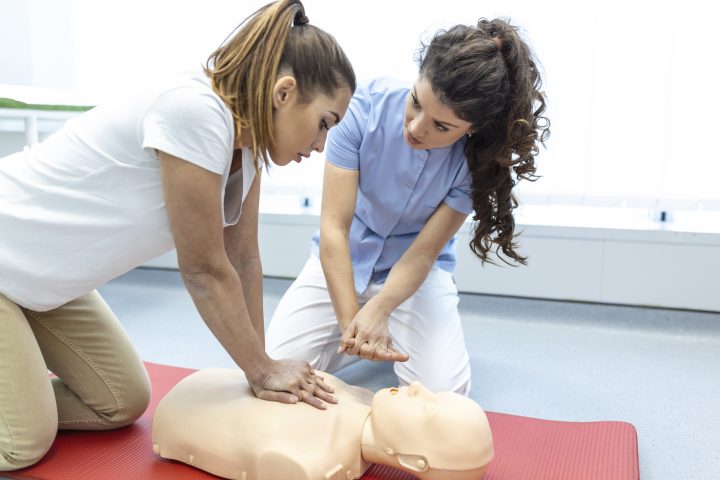First responders, including EMTs, paramedics, and firefighters, play a critical role in emergency medical care. They are often the first to arrive at the scene of a medical crisis, where they must quickly assess, stabilize, and transport patients. In these high-stress situations, Basic Life Support (BLS) and Advanced Cardiovascular Life Support (ACLS) protocols are crucial for saving lives.
1. The Role of BLS in Emergency Response
BLS (Basic Life Support) focuses on providing immediate, non-invasive care to patients in life-threatening situations, particularly those experiencing cardiac arrest, respiratory distress, or choking.
Key BLS Actions Performed by First Responders:
✅ Assessing the Scene & Patient:
- Ensure safety before providing care.
- Check responsiveness, breathing, and pulse.
✅ Performing High-Quality CPR:
- Chest compressions at a rate of 100-120 per minute (2-inch depth for adults).
- Rescue breaths if trained (or Hands-Only CPR if untrained).
✅ Using an AED (Automated External Defibrillator):
- Analyzing heart rhythms.
- Delivering an electric shock if needed.
✅ Airway Management:
- Providing oxygen support via a bag-valve mask (BVM).
- Performing the Heimlich maneuver for choking victims.
BLS is critical in the first few minutes of a medical emergency before ACLS interventions become necessary.
2. The Role of ACLS in Advanced Emergency Care
While BLS keeps a patient stable, ACLS (Advanced Cardiovascular Life Support) is used when more advanced interventions are required, such as medication administration, airway management, and cardiac rhythm analysis.
Key ACLS Actions Performed by First Responders:
✅ Advanced Airway Management:
- Intubation for patients struggling to breathe.
- Suctioning secretions or clearing obstructions.
✅ Intravenous (IV) or Intraosseous (IO) Medication Administration:
- Epinephrine for cardiac arrest.
- Amiodarone or Lidocaine for ventricular arrhythmias.
- Atropine for bradycardia.
✅ ECG Rhythm Interpretation & Defibrillation:
- Recognizing life-threatening arrhythmias (V-Fib, V-Tach, Asystole, PEA).
- Delivering synchronized cardioversion or defibrillation as needed.
✅ Treating Stroke and Heart Attack Symptoms:
- Oxygen therapy and aspirin for suspected myocardial infarction (MI).
- Stroke recognition (FAST: Face drooping, Arm weakness, Speech difficulty, Time to call 911).
ACLS is typically used by paramedics and higher-level first responders who are trained in advanced interventions.
3. BLS vs. ACLS: Who Uses What in the Field?
| Responder Level | BLS Skills | ACLS Skills |
|---|---|---|
| Basic EMTs (Emergency Medical Technicians) | ✅ CPR, AED, oxygen therapy, basic airway management | ❌ No ACLS interventions |
| Advanced EMTs | ✅ BLS interventions | ⚠️ Limited ACLS (some meds, advanced airway) |
| Paramedics | ✅ Full BLS | ✅ Full ACLS (intubation, meds, ECG interpretation) |
| Firefighters & Police Officers | ✅ Often trained in BLS | ❌ No ACLS interventions |
BLS is the foundation of all emergency medical response, while ACLS is used for patients needing more complex interventions before hospital arrival.
4. The Golden Hour: Why Early BLS & ACLS Matter
🚑 Every minute counts! A person in cardiac arrest has only a 5-10% survival chance per minute without CPR. First responders must act quickly:
1️⃣ First 3-5 minutes:
- Start BLS (CPR & AED) to maintain circulation and oxygenation.
2️⃣ Within 10 minutes:
- ACLS interventions (medications, advanced airway, defibrillation) increase survival chances.
3️⃣ Transport to Hospital:
- Continued ACLS during transit.
- Handoff to ER for definitive care (e.g., PCI for heart attack).
The faster BLS and ACLS are initiated, the greater the patient’s survival rate!
Conclusion: The Life-Saving Power of BLS & ACLS
First responders are the critical link between sudden medical emergencies and hospital care. Their ability to deliver high-quality BLS and ACLS interventions in the field can mean the difference between life and death.
By ensuring early CPR, rapid defibrillation, and timely advanced care, they give patients the best possible chance of survival before reaching the hospital.


